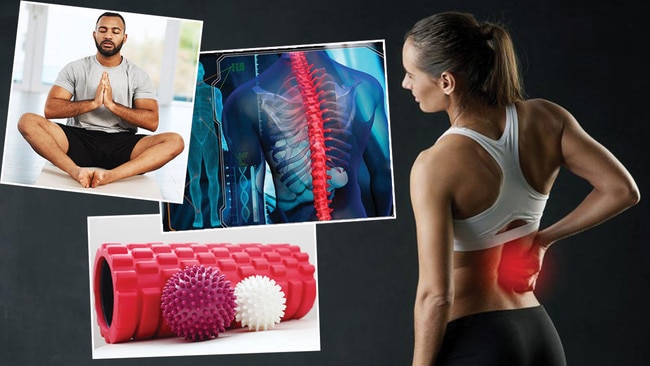How to fix your back: what spinal health scientists recommend
Exercise, osteopathy, ‘rewiring’ your brain … the key to staying pain-free is experimentation. Here’s what the experts recommend.

A cure for back pain remains elusive and those experiencing it face a bewildering array of options, from gadgets and therapies to exercise classes and supplements promising to treat it. With so much conflicting evidence and advice, where to start?
For a recent BMJ study, a team led by Professor Paulo Ferreira and Emma Ho from the University of Sydney’s medicine faculty attempted to provide clearer guidance for people with chronic low back pain, defined as pain that lasts more than 12 weeks.
It is well known that those living with the condition not only experience physical pain but often also suffer psychological distress in the form of anxiety, depression or fear of pain from movement, so the researchers analysed close to 100 trials involving more than 13,000 patients, comparing 17 treatments including “talking therapies” such as cognitive behavioural therapies (CBT), mindfulness, counselling and pain education programs as well as physiotherapy and general GP care.
Their conclusion? A gold standard approach doesn’t just focus on physical elements of back pain by correcting issues such as posture but incorporates approaches that strengthen the mind.
“Treating back pain is never straightforward,” says Jack Chew, a musculoskeletal specialist physiotherapist and spokesman for the Chartered Society of Physiotherapy. “We do know there is no single treatment approach that works in isolation.” What works for one person will not necessarily work for the next, which can complicate the process of prescription and recovery. “Each of us has highly individual levels of pain tolerance,” he says. “Some people feel a lot of pain when there is very little muscle tissue damage, others don’t present with back pain until a point when damage is quite severe and yet they have felt little discomfort.”
Ultimately, he says, relief from back pain comes down to trying different things to find out what works for you. “There are treatment trends that come and go, but some facts remain constant. For a strong, healthy back you need to move more, and relief from chronic back pain means addressing body and mind.” Here’s the latest thinking on how to do it.
Don’t ignore your core
A weak core is a known risk factor for back pain and strengthening the muscles that comprise it – including the pelvic floor muscles, the deep transversus abdominis, and muscles such as the internal and external obliques and erector spinae that wrap around your middle like a corset to improve control of the spine and pelvis - can help to prevent pain.
A study of recreational runners published in the Journal of Biomechanics suggested that those with weak deep core muscles were at higher risk of low back pain because other more superficial muscles were forced to work harder to support the body during exercise. “That increases the load on your spine in a way that may lead to low back pain,” said the lead author of the paper, Ajit Chaudhari, associate professor of physical therapy and biomedical engineering at Ohio State University.
Ironically, training routines focused on the core in isolation are not a solution. When he reviewed benefits of specific types of core-strengthening and other exercises for a 2020 study in the British Journal of Sports Medicine, Daniel Belavy, an associate professor at the Institute for Physical Activity and Nutrition at Deakin University in Australia, found Pilates and stabilisation exercises that subtly target specific core muscles are helpful for many people. However, he stressed that they should form one part of an overall activity routine that also includes resistance training for stronger back muscles and aerobic activity for improvements in functional movement and pain relief.
Rewire your brain
Chronic musculoskeletal pain is not just physical, and experts believe that pain signals continue to be fired off even after healing of muscles and tissues has occurred. If you’ve had back pain, this could prompt a fear of it recurring, which could become the biggest stumbling block to recovery.
“Unfortunately, pain is not a very distinguished alarm system,” Chew says. “Sometimes it signals danger, but it can also keep sounding when our backs are relatively OK, which means we adapt behaviour and are overcautious with the way we move.”
Rewiring your brain to think differently about pain and disability can be hugely beneficial. Chew says: “Rewiring the brain entails adopting psychological approaches such as CBT and mindfulness as well as exposing yourself to movements such as twisting, lifting and bending that you might perceive to be harmful.”
In the University of Sydney BMJ paper Ferreira and Ho found that CBT and an education program that teaches people how to deal with pain alongside conventional physiotherapy worked best at reducing fear avoidance and improving physical function in the first two months of treatment, with continuing pain education work and physiotherapy helping to keep back pain at bay.
Consider seeing an osteopath
A newly published scientific paper suggests osteopathy, which involves manipulation of the body’s tissues and bones, “could be effective in the management of musculoskeletal disorders” including back pain.
Researchers from the School of Osteopathy in Turin published their findings in the BMJ Open journal after reviewing 55 trials carried out by registered osteopaths or doctors with osteopathic training and involving 3,740 participants. They compared the treatment with physiotherapy, other complementary approaches, and the usual advice to exercise, use painkillers and apply hot and cold compression, and found osteopathy to be helpful for some people.
Others have shown massage to be helpful. Manual therapies in general are gaining in credibility and you can now see an osteopath on the NHS.
Belavy’s research suggested that most popular treatments have little impact unless combined with exercise, and Nice guidelines recommend manual therapies alongside physical activity as a treatment option for lower back pain.
Dig in the garden
Nils Niederstrasser, a senior lecturer in the department of psychology, and his team at the University of Portsmouth recently reviewed data from 5,802 people aged 50 or older over ten years and reported that activities such as digging the garden can strengthen back and core muscles and lower the risk of developing back pain in the long term. However, you do need to do this high-effort work regularly for benefits. “At least once a week you need to do an activity that is vigorous enough to leave you sweating and digging the garden with a spade counts,” Niederstrasser says.
Walk daily for analgesic benefits
Like other aerobic activity, walking stimulates the brain into releasing serotonin and endorphins, neurotransmitter chemicals that make you feel better even when you have finished. One study of more than 5,000 adults over the age of 50, some of whom had experienced back pain for a month or more, found that those who walked for up to an hour at least three times a week were less likely to have low back pain. “Walking is one of the best things you can do for back health,” Chew says.
Gadgets might bring relief
Although the market for back pain aids is huge, few gadgets have been shown to make a significant difference in the long term. But Chew says that we shouldn’t discount them because some might bring short-term relief. “People might take a painkiller to help them through the day and recognise it helps but is not a cure for back pain,” Chew says. “The same is true of gadgets from massage guns to foam rollers and muscle taping to heat pads, which essentially administer pleasant feelings and some transient relief but won’t prevent pain from recurring.”
Try yoga and meditation
For some people a daily yoga and meditation combo is more effective at easing back pain than taking over-the-counter painkillers. In one study published in the Journal of the American Medical Association a group with long-term back pain were assigned an eight-week course of yoga and mindfulness meditation, a CBT talking therapy or to stick with their usual approach and take ibuprofen for pain. Results showed that 47 per cent of those in the yoga and mindfulness group said their back pain had improved; a similar number (52 per cent) reported improvements with CBT, with both proving more effective than painkillers. A year later 68 per cent of the group who continued with their yoga practice, and 59 per cent of the CBT group, had less back-related disability. “The effects seem to get stronger,” the researchers said.
The Times







To join the conversation, please log in. Don't have an account? Register
Join the conversation, you are commenting as Logout